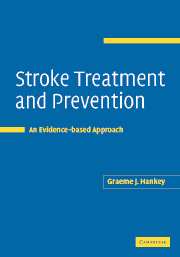Book contents
- Frontmatter
- Contents
- Preface
- 1 The size of the problem of stroke
- 2 Understanding evidence
- 3 Organised acute stroke care
- 4 General supportive acute stroke care
- 5 Reperfusion of ischaemic brain by thrombolysis
- 6 Augmentation of cerebral blood flow: fibrinogen-depleting agents, haemodilution and pentoxifylline
- 7 Neuroprotection
- 8 Treatment of brain oedema
- 9 Anticoagulation
- 10 Antiplatelet therapy
- 11 Carotid artery revascularisation
- 12 Lowering blood pressure
- 13 Lowering blood cholesterol concentrations
- 14 Modification of other vascular risk factors and lifestyle
- 15 Antithrombotic therapy for preventing recurrent cardiogenic embolism
- 16 Arterial dissection and arteritis
- 17 Treatment of intracerebral haemorrhage
- 18 Treatment of subarachnoid haemorrhage
- References
- Index
8 - Treatment of brain oedema
Published online by Cambridge University Press: 23 December 2009
- Frontmatter
- Contents
- Preface
- 1 The size of the problem of stroke
- 2 Understanding evidence
- 3 Organised acute stroke care
- 4 General supportive acute stroke care
- 5 Reperfusion of ischaemic brain by thrombolysis
- 6 Augmentation of cerebral blood flow: fibrinogen-depleting agents, haemodilution and pentoxifylline
- 7 Neuroprotection
- 8 Treatment of brain oedema
- 9 Anticoagulation
- 10 Antiplatelet therapy
- 11 Carotid artery revascularisation
- 12 Lowering blood pressure
- 13 Lowering blood cholesterol concentrations
- 14 Modification of other vascular risk factors and lifestyle
- 15 Antithrombotic therapy for preventing recurrent cardiogenic embolism
- 16 Arterial dissection and arteritis
- 17 Treatment of intracerebral haemorrhage
- 18 Treatment of subarachnoid haemorrhage
- References
- Index
Summary
Brain oedema sufficient to cause mass effect and compress adjacent brain structures (e.g. cerebrospinal fluid (CSF) pathways, long tracts, cranial nerves), or increase intracranial pressure (ICP) and lead to herniation, occurs in up to 10% of patients with ischaemic stroke, mainly those with large infarcts. Much of the brain swelling is due to cytotoxic oedema, which is related to ischaemic dysfunction of the cell membrane (e.g. sodium–potassium adenosine triphosphatase (ATPase) pump).
Cytotoxic brain oedema develops in the first few hours after the onset of ischaemic stroke and can be detected on magnetic resonance imaging (MRI) brain scan as a decrease in the apparent diffusion coefficient (ADC) of water. However, brain oedema is usually not sufficiently large in the first 24 h of the stroke to be clinically significant except among patients with large cerebellar infarcts. The MRI brain appearances of cytotoxic brain oedema (a reduction in ADC) lasts for 3–4 days, and then vasogenic oedema develops (Schlaug et al., 1997). The complications of brain oedema usually peak at 3–5 days after ischaemic stroke.
The management of clinically significant brain oedema aims to:
reduce mass effect and ICP,
maintain adequate cerebral perfusion to avoid worsening of the brain ischaemia,
prevent secondary brain injury from herniation. Strategies to reduce mass effect and ICP include:
elevate the head of the bed to 20–30 degrees to assist cerebral venous drainage;
mild fluid restriction;
avoid hypo-osmolar fluids, such as 5% dextrose in water, which may worsen oedema (Ropper and Shafran, 1984);
avoid anti-hypertensive drugs that induce cerebral vasodilatation;
[…]
- Type
- Chapter
- Information
- Stroke Treatment and PreventionAn Evidence-based Approach, pp. 157 - 167Publisher: Cambridge University PressPrint publication year: 2005



